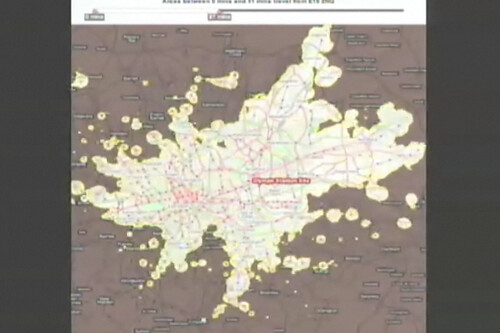How many remotes are sitting on your coffee table? According to the Consumer Electronics Association, an average American home has 4 remotes, and there could be up to 5 or 6 remotes for running a home theater. Another study by research firm Gfk shows 49% of European households having 5 or more remote controls and 87% having 3 or more. This research claims that, in a quarter of European homes, there is only one person who knows how to operate all the technology. This is exactly what happened in our house. With many look-alike remotes in my hands, I couldn’t survive without the cheat sheets that my husband made for me explaining how to control each system. Universal remotes provide one alternative (CNet recommends the $249.99 Logitech Harmony One) but they can be expensive, cumbersome to set up, confusing to operate, and not always compatible. There has got to be a better way to control our electronics.
Spend an extra $250 to clean up my coffee table? I’m not so sure. Why not use my mobile phone to do this? It’s sleek and handy. It’s got buttons, big screen, and a bunch more options and advanced capabilities (motion sensor, Wi-Fi, GPS, etc.). Given all this, it’s not a stretch to think that a phone could be turned into the best universal remote ever.
Therefore, here are Five Design Considerations for Mobile Phone as Universal Remote Control:
1// Provide Automatic Configuration
The first user experience is critical, so automate anything you can. Before enjoying a media experience with a new remote, the very first two steps everyone must complete are compatibility check and configuration. Ironically, this process is often frustrating and time-consuming. People have to find out and hand-enter a series of manufacturer model numbers for every piece of electronic equipment, and must continually test and refine the settings. Why not make this process more automatic by utilizing RFID or bar code system technology? The mobile phone becomes the receiver (radio wave pointer) for RFID, auto-detecting and auto-generating a component list. At the same time, the compatibility check and configuration can happen over the network, storing information both on phone and online for backup.
2// Display the Right Controls at the Right Time
Showing all options at once is not helpful. A constant problem with universal remotes is that people have trouble finding the correct buttons after turning the whole system on. This problem becomes even more confusing when we try to control EVERYTHING with this one magic wand. To solve this we need to simplify the button controls, and provide clear feedback and guidance to users. For example, there’s no need to show channel controls when watching a DVD. Display necessary functions that relate to the currently selected mode, plus some means to expose the other options when needed. In addition, provide visual and / or haptic feedback whenever the user touches a control. The feedback not only allows the user to see what they are doing, but also prevents them from getting lost.
3// Make It Personal!
Your mobile phone is very personal, so your mobile remote control should be too. Turning the phone into a universal remote enables more specific personalization, and opens all kinds of possibilities. Each person can have his or her own unique experience based on the remote settings. For instance, I can reorganize my TV guide, only keeping the channels that interest me. My husband (a sports fan) might set up game night alerts for himself and his buddies as well. My mom would prefer bigger text on her remote and higher volume for her TV watching. With the right privacy safeguards, these personalized experiences could even help to improve the precision of recommendation engines and marketing opportunities.
4// Consider Hardware Variations
Mobile UI design could never stand alone without consideration of hardware. For a remote control interface, the command input method plays a significant role. The input methods for present and future media devices could be Wii-like pointers, touch screens, 5-way devices, scroll balls, QWERTY keypads, etc. The interface design of each input method could vary dramatically according to its hardware limitation or strength. A good solution for the mobile device remote should take all relevant control methods into account. The other challenge here is to figure out a rule for when and how to show information on both input device display and the output screen. Understanding the screen size, orientation, and resolution in a given viewing scenario can help to guide solutions. Of course in turning a mobile phone into a remote, the necessary first step is to give the phone the hardware to communicate with the media devices, whether via radio, ultrasonic, laser, infrared , etc.
5// Be Aware of Context
Context is king when designing for mobile products. People want to control different things in different times, locations, and situations. You would never want to turn on the TV in the living room when you are in bed. Likewise, when you are watching a movie at home and a call comes in – wouldn’t you like the phone to automatically pause the movie while you’re on the call and then put it back on when you hang up? These features are possible if the application is designed with contextual awareness.
Ifan Chou is an interaction designer at Punchcut. Gabriel White is the Interaction Design Director at Punchcut. Photo by Flickr user buttha used under Creative Commons.
Add this to digg, del.icio.us, etc.




